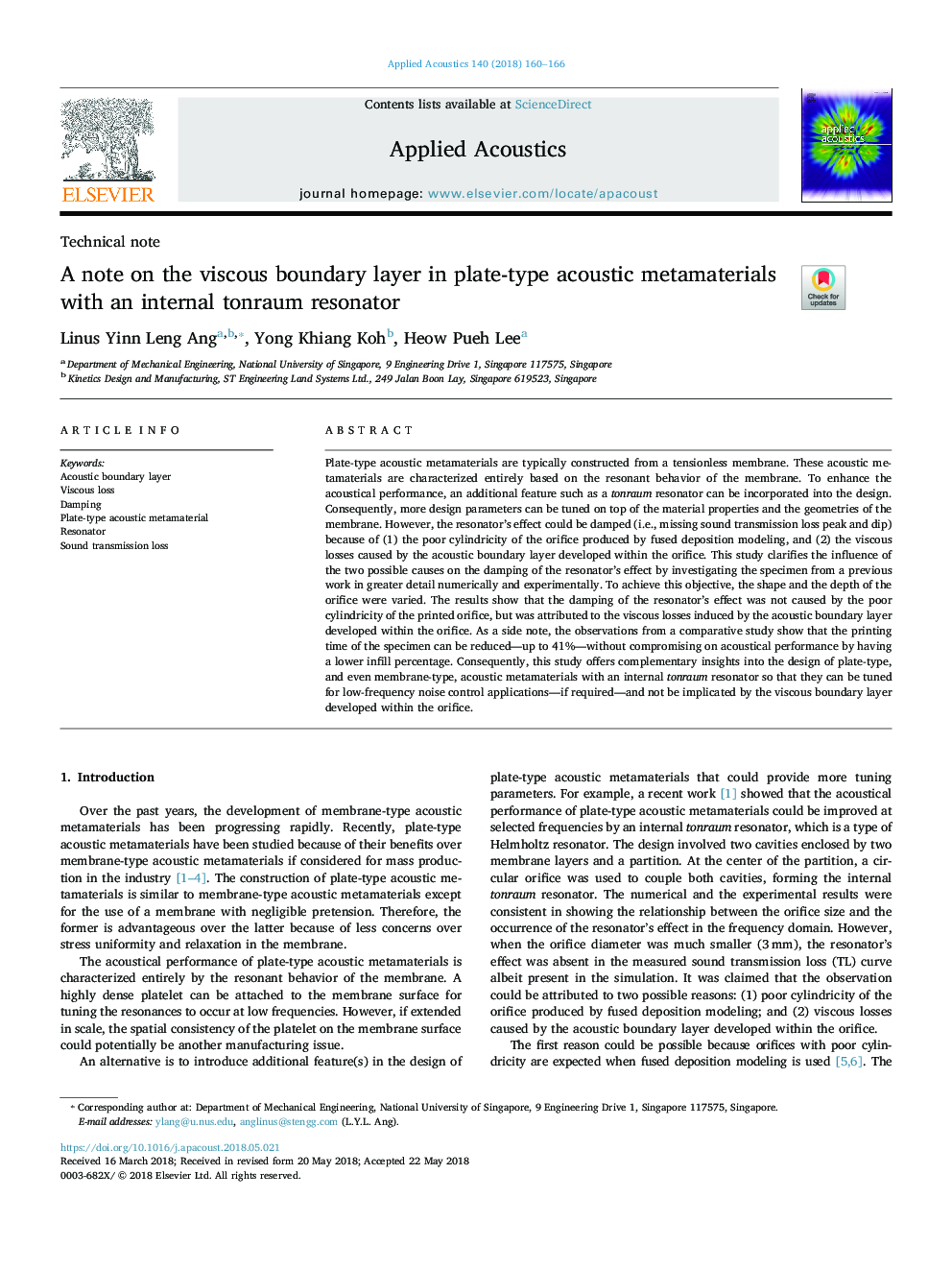| کد مقاله | کد نشریه | سال انتشار | مقاله انگلیسی | نسخه تمام متن |
|---|---|---|---|---|
| 7152094 | 1462370 | 2018 | 7 صفحه PDF | دانلود رایگان |
عنوان انگلیسی مقاله ISI
A note on the viscous boundary layer in plate-type acoustic metamaterials with an internal tonraum resonator
ترجمه فارسی عنوان
یادداشتی در مورد لایه مرزی چسبنده در مواد متخلخل نوع صوتی با یک رزوناتور تونریم داخلی
دانلود مقاله + سفارش ترجمه
دانلود مقاله ISI انگلیسی
رایگان برای ایرانیان
کلمات کلیدی
لایه مرزی آکوستیک، از دست دادن ویسکوز، دمیدن، نوع متالورژی نوع صوتی، رزوناتور، از دست دادن انتقال صدا
ترجمه چکیده
انواع متالورژی صوتی نوعی پلاستیکی معمولا از یک غشای بدون تنش ساخته می شوند. این فلزات صوتی به طور کامل بر اساس رفتار رزونانس غشا مشخص می شود. برای بهبود عملکرد صوتی، ویژگی های اضافی مانند رزوناتور تونرام می تواند در طراحی گنجانده شود. در نتیجه، پارامترهای طراحی بیشتر می توانند بر روی خواص مواد و هندسه غشاء تنظیم شوند. با این حال، اثر رزوناتور می تواند خنثی شود (به عنوان مثال، از دست دادن انتقال صوت از دست رفتن پیک و شیب) به علت (1) سیلندری فقیر از خروجی تولید شده توسط مدل سازی رسوبدهی مخلوط، و (2) زیان های چسبنده ناشی از لایه مرزی آکوستیک توسعه یافته در داخل سوراخ این مطالعه تاثیر دو علت احتمالی در کاهش اثر رزوناتور را با بررسی نمونه از یک کار قبلی به صورت عددی و آزمایشگاهی بیشتر توضیح می دهد. برای رسیدن به این هدف، شکل و عمق سوراخ متنوع بود. نتایج نشان می دهد که محرک اثر رزوناتور ناشی از سیلندر ضعیف سوراخ چاپ شده نیست، بلکه به زیان های چسبنده ناشی از لایه مرزی صوتی که در داخل سوراخ ایجاد شده است، مربوط می شود. به عنوان یک یادداشت جانبی، مشاهدات از یک مطالعه مقایسه ای نشان می دهد که زمان چاپ نمونه می تواند تا 41 درصد کاهش یابد - بدون داشتن سازگاری با عملکرد آکوستیک با داشتن درصد پایین تر از حد مطلوب. در نتیجه، این مطالعه بینش متقابل را به طراحی نوع بشقاب و حتی غشاء نوع متاموئید آکوستیک با رزوناتور تونرور داخلی ارائه می دهد به طوری که آنها می توانند برای برنامه های کنترل کنترل نویز کم تنظیم - در صورت لزوم - و نمی شود توسط لایه مرزی چسبناک درون سوراخ ایجاد شده است.
موضوعات مرتبط
مهندسی و علوم پایه
سایر رشته های مهندسی
مهندسی مکانیک
چکیده انگلیسی
Plate-type acoustic metamaterials are typically constructed from a tensionless membrane. These acoustic metamaterials are characterized entirely based on the resonant behavior of the membrane. To enhance the acoustical performance, an additional feature such as a tonraum resonator can be incorporated into the design. Consequently, more design parameters can be tuned on top of the material properties and the geometries of the membrane. However, the resonator's effect could be damped (i.e., missing sound transmission loss peak and dip) because of (1) the poor cylindricity of the orifice produced by fused deposition modeling, and (2) the viscous losses caused by the acoustic boundary layer developed within the orifice. This study clarifies the influence of the two possible causes on the damping of the resonator's effect by investigating the specimen from a previous work in greater detail numerically and experimentally. To achieve this objective, the shape and the depth of the orifice were varied. The results show that the damping of the resonator's effect was not caused by the poor cylindricity of the printed orifice, but was attributed to the viscous losses induced by the acoustic boundary layer developed within the orifice. As a side note, the observations from a comparative study show that the printing time of the specimen can be reduced-up to 41%-without compromising on acoustical performance by having a lower infill percentage. Consequently, this study offers complementary insights into the design of plate-type, and even membrane-type, acoustic metamaterials with an internal tonraum resonator so that they can be tuned for low-frequency noise control applications-if required-and not be implicated by the viscous boundary layer developed within the orifice.
ناشر
Database: Elsevier - ScienceDirect (ساینس دایرکت)
Journal: Applied Acoustics - Volume 140, November 2018, Pages 160-166
Journal: Applied Acoustics - Volume 140, November 2018, Pages 160-166
نویسندگان
Linus Yinn Leng Ang, Yong Khiang Koh, Heow Pueh Lee,
